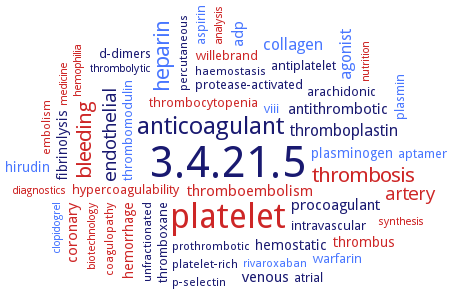3.4.21.5: thrombin
This is an abbreviated version!
For detailed information about thrombin, go to the full flat file.

Word Map on EC 3.4.21.5 
-
3.4.21.5
-
platelet
-
anticoagulant
-
heparin
-
thrombosis
-
bleeding
-
endothelial
-
artery
-
thromboplastin
-
collagen
-
agonist
-
thromboembolism
-
coronary
-
procoagulant
-
adp
-
antithrombotic
-
venous
-
fibrinolysis
-
thrombus
-
hemorrhage
-
hemostatic
-
hirudin
-
plasminogen
-
antiplatelet
-
thrombomodulin
-
protease-activated
-
arachidonic
-
plasmin
-
thromboxane
-
intravascular
-
viii
-
d-dimers
-
atrial
-
thrombocytopenia
-
aspirin
-
aptamer
-
hypercoagulability
-
willebrand
-
warfarin
-
percutaneous
-
p-selectin
-
rivaroxaban
-
platelet-rich
-
unfractionated
-
coagulopathy
-
prothrombotic
-
embolism
-
haemostasis
-
diagnostics
-
analysis
-
hemophilia
-
biotechnology
-
thrombolytic
-
nutrition
-
synthesis
-
clopidogrel
-
medicine
- 3.4.21.5
- platelet
-
anticoagulant
- heparin
- thrombosis
- bleeding
- endothelial
- artery
- thromboplastin
- collagen
- agonist
- thromboembolism
- coronary
-
procoagulant
- adp
-
antithrombotic
- venous
-
fibrinolysis
- thrombus
- hemorrhage
-
hemostatic
- hirudin
- plasminogen
-
antiplatelet
- thrombomodulin
-
protease-activated
-
arachidonic
- plasmin
-
thromboxane
-
intravascular
- viii
-
d-dimers
- atrial
- thrombocytopenia
- aspirin
- aptamer
- hypercoagulability
- willebrand
- warfarin
-
percutaneous
-
p-selectin
- rivaroxaban
-
platelet-rich
-
unfractionated
- coagulopathy
-
prothrombotic
- embolism
-
haemostasis
- diagnostics
- analysis
- hemophilia
- biotechnology
-
thrombolytic
- nutrition
- synthesis
- clopidogrel
- medicine
Reaction
selective cleavage of Arg-/-Gly bonds in fibrinogen to form fibrin and release fibrinopeptides A and B =
Synonyms
activated factor II, alpha-thrombin, alphaTh, beta-thrombin, blood-coagulation factor II, activated, blood-coagulation factor IIa, clotting factor IIa, EC 3.4.4.13, factor IIa, fibrinogenase, thrombase, thrombin, E, thrombin-C, thrombofort, TLE2, topical, tropostasin
ECTree
Advanced search results
Source Tissue
Source Tissue on EC 3.4.21.5 - thrombin
Please wait a moment until all data is loaded. This message will disappear when all data is loaded.
-
sections from Alzheimer's disease brains show reactivity to thrombin antibody in blood vessel walls but not in vessels from controls

-
high levels of thrombin are detected in cerebrospinal fluid obtained from Alzheimer's disease but not control patients

-
thrombin induces a phosphoinositide 3-kinase-Akt pathway-dependent acquisition of dermal-sheath-like properties by dermal papilla cells in vitro, involving increased proliferation rate, acquisition of myofibroblastic contractile properties and a decreased capacity to sustain growth and survival of keratinocytes. The thrombin inhibitor protease nexin 1 regulates all those effects in vitro. Control of thrombin signaling interferes with hair follicle dermal cells plasticity to regulate their function

-
both thrombin and thrombin receptor agonist peptide enhance the permeability barrier of cells, both exhibit a potent barrier protective effect when cells are treated with inactive mutant S195A of protein C prior to stimulation. Thrombin exhibits a potent cytoprotective activity in the lipopolysaccharide-induced permeability and tumor necrosis factor alpha-induced apoptosis and adhesion assays in the protein C mutant S195A treated cells. Treatment with the cholesterol depleting molecule methyl-beta-cyclodextrin eliminates the protective effect

-
both thrombin and thrombin receptor agonist peptides initiate proinflammatory responses in cells. The occupancy of endothelial protein C receptor by the inactive protein C mutant S195A switches the receptor PAR-1-dependent signaling specificity of thrombin leading to thrombin inhibition of the expression of cell surface adhesion molecules CCAM-I, ICAM-I and E-selectin as well as the binding of neutrophils to tumor necrosis factor alpha-activated endothelial cells. Both thrombin and thrombin receptor agonist peptides activate Rac I and inhibit the activation of RhoA and nuclear factor kappaB pathways in response to tumor necrosis factor alpha in cells pretreated with protein C mutant S195A

-
thrombin is highly expressed in microvessels from Alzheimer's disease brains but is not detectable in control vessels

additional information
-
-
701289, 707386, 707408, 707941, 707944, 707945, 708154, 708178, 708274, 708363, 709161, 709693, 710224, 710610, 710634, 717955

-
exogenous oxidative stress, thrombin activation, progression of ageing and type 2 diabetes lead to protein carbonyls formation in platelets, and this modification can be attenuated by antioxidant enzymes

-
exogenous oxidative stress, thrombin activation, progression of ageing and type 2 diabetes lead to protein carbonyls formation in platelets, and this modification can be attenuated by antioxidant enzymes

-
exogenous oxidative stress, thrombin activation, progression of ageing and type 2 diabetes lead to protein carbonyls formation in platelets, and this modification can be attenuated by antioxidant enzymes

-
brain endothelial cells can synthesize thrombin and thus be a source of this neurotoxin in Alzheimer's disease brains

-
-
650344, 652054, 652062, 652618, 652872, 653290, 653969, 653978, 699865, 717199, 717496, 731132, 731294, 731307, 732938

-
craniocerebral trauma patients present a state of hypercoagulability at early stage and thrombin content is very high level at the site of injury

additional information
-
the presence of thrombin induces a significant increase in matrix metalloprotease-9 activity and also increases its mRNA expression in primary astrocytes. Thrombin-induced matrix metalloprotease-9 production is inhibited by the selective inhibitor of protease-activated receptor PAR-1, SCH 79797 and by PDS98059



 results (
results ( results (
results ( top
top






